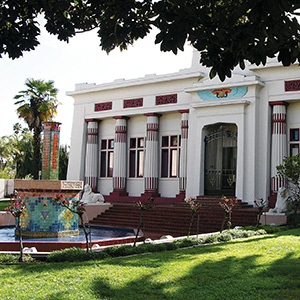

In the summer of 2015, the old Rose-Croix University building at Rosicrucian Park will complete a transmutation into a newly equipped facility to showcase all aspects of the ancient art of alchemy, making San Jose home to the largest alchemy museum in the world.
There will be interactive hands-on exhibits, classroom lectures, a working alchemy laboratory, events in the auditorium and more. It will be the only facility of its kind in the United States. The Rosicrucians claim alchemy originated in Ancient Egypt, so next summer, they will stage an exhibit in the Egyptian Museum to start ratcheting up the celebration for the new facility.
Ancient alchemists in both West and East claimed to search for ways of converting base metals into gold, and their terminology contributed to the development of modern chemistry, although people for centuries have argued over the degree to which the alchemical process was mental, physical, spiritual, psychological or all of the above. Meaning, were the alchemists literally trying to convert lead into gold, or was it an allegory for personal growth? Were all those diagrams filled with coded symbology meant to suggest something quite different? That is, was all the laboratory terminology just allegory for a process of fine tuning one’s own personal path, i.e., boiling away the bad elements and transforming other elements in order to sculpt a better self? Who knew what, and when?
What is common knowledge is that earlier in the 20th century, Carl Gustav Jung brought alchemical symbolism and terminology into the practice of dream analysis and psychology, exploring how it relates to everyone’s own inner journey. Ever since Jung, alchemy has been going through a period of resurgence, so to speak, even in Hollywood films.
In the 1930s, just after the Rosicrucians first set up their world headquarters in San Jose, the operation included an alchemical school of sorts, as part of the Rose-Croix University, replete with classrooms, an alchemy lab and an herborium. Much of the original facility still exists, although it hasn’t been open to the public in decades. In 2015, that will change.
Dennis William Hauck is the curator of the alchemy museum. An author, consultant and lecturer, he is the de facto public face of the modern alchemy world laboratory. He wrote The Complete Idiot’s Guide to Alchemy, plus another one called, The Emerald Tablet: Alchemy for Personal Transformation, and also penned, Sorcerer’s Stone: A Beginner’s Guide to Alchemy. Over the phone, Hauck told me that the Rosicrucians, centuries ago, were among the first ones to articulate the mental aspects of alchemy and the transpersonal components of the process, back when the protoscientists were still toiling away with beakers and furnaces. The establishment of a new alchemy museum is a natural way for the Rosicrucians to reconnect with their traditions.
“About 1500 A.D., the Rosicrucians really made a difference in alchemy,” Hauck said. “They took it towards a more spiritual, evolutionary type of idea. And they posited the alchemical laboratory experience as a spiritual experience too. They were saying that the operations of alchemy apply not only in the laboratory, but also psychologically. And that thread was eventually taken up by Jung in an amazing manner.”
According to Hauck, the Rosicrucian contribution to history was to expand alchemy on three levels—physical, mental and spiritual—which was a significant difference compared to just trying to convert base metals into gold and a big change from simply searching for the physical elixir of life. San Jose should be proud of that entire city block at Park and Naglee.
The new museum will even have seven different rooms of exhibits, devoted to the seven phases of alchemical transformation: Calcination, Dissolution, Separation, Conjunction, Fermentation, Distillation, and Coagulation. Each room will be filled with colors, sounds, equipment and symbolism related to each phase. Visitors will thus be able to physically walk from room to room, passing through the seven stages of the process, in proper order. Hauck says the Rosicrucians were the ones who originally deciphered the proper order of the seven stages in the first place.
“It’ll be a unique place,” Hacuk said. “It’s an exciting project.”


